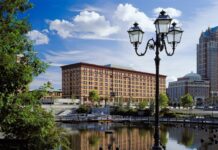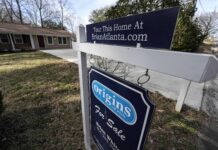John McKee is the regional operations director for Peabody Properties Inc., which is leasing and managing The Residences at Lincoln Park, in Dartmouth. The affordable housing community, now in its third phase, has been developed over the former Lincoln Park amusement park. The final phase, apartments for tenants age 55 and older, is nearing completion. The project has 126 apartment homes.
PBN: Most older Rhode Islanders have visited Lincoln Park as an amusement park. When was it redeveloped into the Residences at Lincoln Park, and give us an overview of the development.
MCKEE: Construction for the first building, of 36 affordable apartment homes, commenced on July 1, 2015, and was completed on Dec. 31, 2015. Residents began moving in the end of January 2016. Shortly thereafter, the market building was constructed with the final phase of construction being the community for residents 55 (and older), which is just about completely leased, with two units remaining.
All four phases of the site, including the stand-alone homes, were built by Bristol Pacific Homes, of Fall River, with development consultant Affirmative Investments, of Boston. [The architect is Khalsa Design of Somerville, Mass.] The project received strong support and assistance from the Massachusetts Department of Housing and Community Development and the town of Dartmouth. The development of Lincoln Park also triggered the reconstruction of the Route 6/177 intersection, which was a major cause of accidents over the years.
PBN: Are the apartments all reserved for affordable housing, or just a portion of them? Do tenants have to be Massachusetts residents?
MCKEE: The community was completed in four phases (the stand-alone homes, then the apartment buildings), with the first apartment building being a 100 percent affordable community, the second building, all market-rate units, and the third building, a 55-plus affordable community. There is no requirement that residents are to be existing Massachusetts residents, as anyone can apply. We have even received an application from a Florida resident wanting to move back east. Income limits are different for each of the affordable buildings. Rents, utility allowance and income limits are based on HUD [Department of Housing and Urban Development] guidelines and subject to change.
PBN: How unusual is the branding for 55 and up? Are these developments becoming more common?
MCKEE: I wouldn’t necessarily call it unusual, but it is a boutique style of housing whereby it is geared toward active older adults. Fifty-five-plus sites offer many amenities geared to this population and promote a strong sense of community resulting in residents having a built-in network of peers. Also, 55-plus communities are often strategically built close to major hubs, making this an attractive alternative for seniors or empty nesters who can no longer stay in their homes or are just looking to downsize.
PBN: You are actively leasing the property now. What has been the response?
MCKEE: The first two buildings are fully leased with a wait list for the affordable building. We are almost fully leased with the 55-plus community at this point, with only two remaining (and we have applicants for these). Just waiting on final approval of their applications, and then we will put future applicants on the waitlist, which can range from three months to over two years.
PBN: Explain the depth of need for affordable housing in southeastern Massachusetts. Is there much available on the rental market?
MCKEE: There is a great need for affordable housing statewide and beyond. As the Boston market continues to climb in price, the effects then ripple toward the greater Boston market and then to markets such as southeastern Massachusetts and Rhode Island. Yet from a developer and management agent perspective, the real trend is to have affordable housing contain the same amenities as market rate housing. To that end, we offer apartments with open and airy living spaces, ample closet space and central air-conditioning.
From a cost-savings perspective, the lighting, windows and doors are energy-efficient, and heat and hot water are included with the rent. Entry into the buildings is with card access and video/audio intercom. The property is also centrally located within minutes of the town’s many recreational activities, shopping and dining.
Mary MacDonald is a staff writer for the PBN. Contact her at macdonald@pbn.com.











